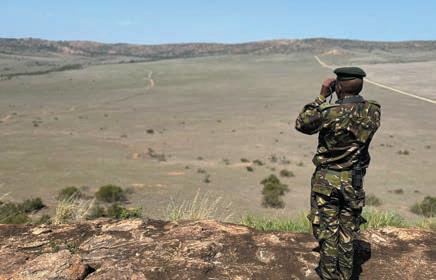
3 minute read
Fundraising Securing our legacy now and in the future
SRI
for rhinos. In turn, this reduces breeding and often leads to more fights between rhinos. For many of these places, finding more, suitable habitats is proving tough.
Advertisement
One of the key options is to establish more partnerships with local people, including communities and private industry. For instance, our report noted that, where rhino populations are managed in diverse models (i.e. not only managed in State areas), they performed better. This was true for all African rhino subspecies other than Northern white rhinos (only two remain, both female, in Kenya).
When a female rhino is lost to poaching, we also lose an average of 4.5 future calves.
Although accountability for rhino conservation is embedded within the mandates of range States, the threats to rhinos are on a global scale and include environmental change. Therefore, international cooperation is key. The only way we can address the unclear risks and threats ahead is by working together to find solutions that support rhino conservation outcomes.

Our vision in the AfRSG is “Thriving wild African rhinos valued by people and contributing to their wellbeing.” Reaching this doesn’t just mean boosting the number of rhinos across range States, it means meaningful participation by, and equitable partnerships with, local people, so that rhinos, and the people they impact, have positive futures.
Since 2017, African range States have...
■ Translocated 391 individual rhinos ■ Dehorned 2,217 rhinos ■ Treated 57 injured and wounded rhinos ■ Recovered 42 rhino orphans
Securing our legacy now and in the future
Jon Taylor | Managing Director, Save the Rhino International
In a past life, I worked for many years on climate change, and I would talk to people about the kind of things we might see in the future if the climate crisis and other environmental challenges weren’t taken seriously. And even though I believed the science, the future world I was describing seemed like something many years away.
In recent years, we have become too used to seeing terrible fires in California, Australia, and this year in Europe too. We have lived through a global pandemic that has crossed from other species to humans and affected the whole world. And as I write this, droughts in China and elsewhere are uncovering archaeology not seen for centuries, while one-third of Pakistan is underwater.
The decisions we make in this crucial decade, in these next few years, will determine the type of world that we bequeath to our children and grandchildren. And Save the Rhino will be at the heart of those discussions, fighting for a climate-resilient world in which people can thrive, buffered, protected and uplifted by healthy, diverse ecosystems that are full of iconic and magnificent wildlife – including, forgive the bias, lots of rhinos!
Of course, all of us who love our natural world need to be acting now, in these crucial times. Perhaps you’re considering how to travel more sustainably, donating to boost rhino conservation activities, or encouraging more wildlife into a nearby green space. But beyond this, you may think about leaving a gift to rhino conservation in your will, to make sure that vital conservation can continue in the years to come.
If that sounds like you, then Save the Rhino has a partnership with the award-winning Farewill team to provide a free willwriting service, either online or, if your will is more complex, by telephone. Just use the code RHINO-HORN22.
Alternatively, if you would like to speak to someone at Save the Rhino about leaving a gift, please call me, Jon Taylor, Save the Rhino’s Managing Director, on +44 (0)20 3918 9057 or email jon@savetherhino.org
A wonderful legacy for future generations is still a possibility. But to achieve this, all of us need to pull together, pull hard, and pull now. I promise you that Save the Rhino will be leading the charge.










